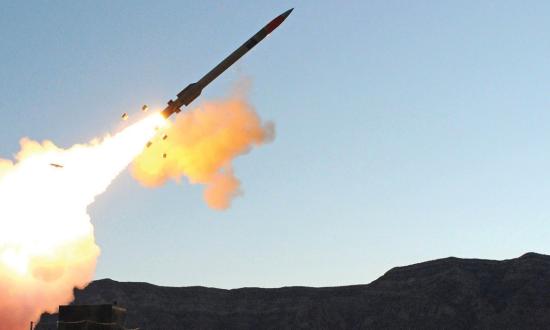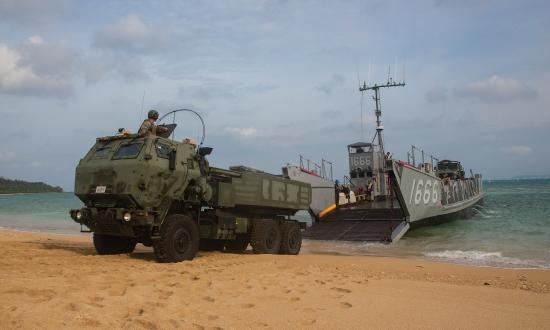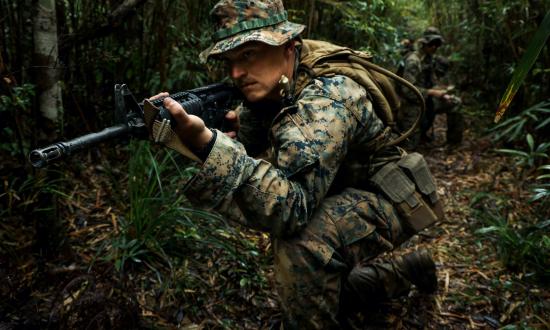In May 2023, the Marine Corps released the second edition of the Tentative Manual for Expeditionary Advanced Base Operations, or TM-EABO. In February 2021, the first edition aimed “to test, refine, and codify the classified Concept for Expeditionary Advanced Base Operations (EABO), signed in March 2019 by both the Commandant of the Marine Corps and Chief of Naval Operations.”
EABO is “a form of expeditionary warfare that involves the employment of mobile, low-signature, persistent, and relatively easy to maintain and sustain naval expeditionary forces from a series of austere, temporary locations ashore or inshore within a contested or potentially contested maritime area in order to conduct sea denial, support sea control, or enable fleet sustainment.” Coupled tightly with the Navy’s concept for distributed maritime operations (DMO), EABO was developed as an approach to warfighting that could mitigate the antiaccess, area-denial (A2/AD) threats posed by adversaries, especially in the littorals.
The first edition of TM-EABO primarily provided a baseline of information—focused on Force Design 2030—to inform the live, virtual, and constructive experimentation to test and refine force structure and capabilities. Iterative by design, the tentative nature of the manual invited and permitted constant refinement based on informed feedback.
The second edition of the TM-EABO reflects the lessons gained from this campaign of learning, provides a refined aimpoint for further continued development, and provides a foundation from which to move from learning to execution. This edition integrates ideas from additional concepts that support EABO, including A Concept for Stand-in Forces.
While much of the content from the first edition is present in the second, there are many essential changes. This includes subjects that are foundational to EABO, as well as significant rewrites of the chapters on aviation and logistics. While practitioners are encouraged to closely follow the development of this concept, a careful reading of each edition of the TM-EABO to identify key differences can be arduous and time consuming. To assist practitioners, some of the key changes in the second edition are discussed below.
Foundations of EABO
Emphasis on Campaigning across the Competition Continuum. The emphasis on campaigning is much stronger in the TM-EABO second edition, and campaigning with EABO across the competition continuum is a theme that runs throughout. This is reinforced by the second edition’s focus on contextualizing EABO at the operational level of planning, priming both commanders and staffs to employ EABO at appropriate levels and to do so with a campaigning concept to favorably shape conditions for friendly forces across time.
Support to the Joint Force, Allies, and Partners. The second edition more holistically integrates the connection between EABO and operations with the joint force, and with allies and partners. This connection appears in both editions, but the second integrates these ideas more frequently and across more activities. This reflects the maturation of thinking about the ability of stand-in forces operating out of expeditionary advanced bases (EABs) to enable the capabilities of higher and adjacent forces, such as transmitting data of an enemy target detected by a sensor at an EAB to a joint or allied fires center for prosecution.
Irregular Threats and Host Nation Populations. The second edition takes a deeper accounting for the human terrain in which stand-in forces will be operating. EABs will be based in foreign countries and surrounded by the populations of the host nation. This presents both opportunities, such as leveraging local economies for sustainment, and risks, such as threats from irregular forces. Notably, such irregular threats are not mentioned at all in the first edition.
The Information Environment. The second edition’s description of the information environment is changed significantly from the description in the first edition. The second edition relies on the most current joint doctrine for information activities, while the first edition relied on the now-defunct Marine Corps service doctrinal concept, “Operations in the Information Environment.” The impacts of this change echo through the second edition, notably with the incorporation of multidomain effects teams into the information forces that might support EABO.
Aviation
Characteristics of Aviation for EABO. The second edition identified three key characteristics for aviation operations in support of EABO that were not in the first: the “persistent distribution of aviation elements across extended distances; operation of distributed aviation elements with minimal sustainment from rear-areas; and networking distributed aviation elements with the littoral force command and control architecture.” These characteristics inform the second edition’s entire discussion of aviation operations.
Modernization and Expansion of the Functions of Marine Aviation. The second edition proposes a modernization of the traditional six functions of Marine Aviation to reduce planning barriers and enhance coordination between the Navy–Marine Corps team. In addition, it proposes adding a seventh function, “aviation ground support,” to clearly outline the roles and responsibilities of logistical and engineer support to an aviation combat element executing EABO.
Tactical Air Command Center (TACC) Distribution. While the first edition does discuss the scalability of the TACC, those implications are not explored in depth. The second edition emphasizes distributing TACC functions and organizations across the battlespace and pushing command authorities down to the lowest possible level. It also notes the potential requirement to locate some TACC functions outside of the weapons engagement zone.
Multi-Function Air Operations Center (MAOC). The second edition discusses a new aviation command-and-control (C2) agency that may be better suited for aviation C2 in the littorals. The MAOC combines the air-defense, air-surveillance, and air-support functions of the TAOC and direct air support into a single, scalable C2 agency capable of employing additional air C2 nodes and teams.
Aviation Ground Support. The second edition includes a thorough discussion and several paragraphs regarding aviation ground support (AGS) and its application in EABO. This reflects a developed understanding of the significant AGS that must accompany aviation operations, and accounts for the need to integrate it into EABO that will incorporate aviation in any meaningful sense.
Logistics
Joint, Allied, and Partnered Logistics. While both editions note the importance of an integrated naval logistics framework, the second edition also emphasizes the joint logistics enterprise and allied and partnered logistics. This facilitates broadened support for movement and sustainment of decentralized forces throughout the littorals.
Supply and Global Positioning Network (GPN). The discussion of supply in the second edition has matured and is more layered. This is demonstrated by a sourcing logic premised on a supply web that expands in echelon and includes EABs, sea basing, regional sources, and global sources. The prepositioning and forward staging of supplies and material that form the GPN further buttress these concepts.
Expeditionary Contracting. While the first edition made mention of this concept, the second edition provides refined detail, proposing expeditionary contracting platoons and practical methods of procurement from local economies.
Engineering. While the first edition only discusses general engineering, the second edition looks at aviation engineering and combat engineering capabilities for EABO. It also identifies mobility, countermobility, survivability, and engineer reconnaissance to enable maneuver, protection, and sustainment of littoral forces.
Health Services, Medical Planning, and Mortuary Affairs. While the first edition briefly touches on health services, the second edition discusses this in-depth and incorporates medical intelligence, medical logistics, medical management, and health-service support planning. Further, the second edition explores mortuary affairs in greater detail, inclusive of mortuary affairs planning, functions, and integration of a mortuary affairs planner into the Marine littoral regiment.
Pioneer Battalions. The second edition discusses a new formation, the pioneer battalion. This formation conducts assured mobility across seaward and landward portions of the littoral operating area. It does so by employing a hybrid team of naval capabilities unconstrained by the water depth, reducing obstacles, and improving routes from the very shallow water limit, inland to interior lines of communication.
Operational Level Logistics. While the first edition focused almost entirely on tactical logistics, the second edition includes a robust exploration of operational level logistics and its impact on EABO. This incorporates force closure, arrival and assembly, and intratheater lift.
An Iterative Document
The second edition of the TM-EABO will be used to further validate, refine, and develop warfighting capabilities and procedures as this concept moves to execution across the Fleet Marine Force. To support this goal, commanders and staffs of naval expeditionary forces should familiarize themselves with the ideas found in the TM-EABO.
This article summarizes some of the most significant changes between the first and second editions of the TM-EABO. Still, practitioners are encouraged to familiarize themselves with the manual in its entirety and contribute to its further refinement as it continues to iterate, and eventually matures, from a tentative manual to doctrine and standard operating procedures.






